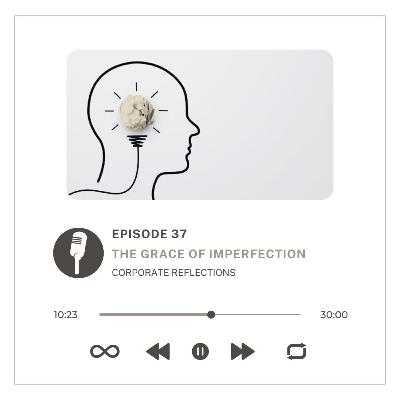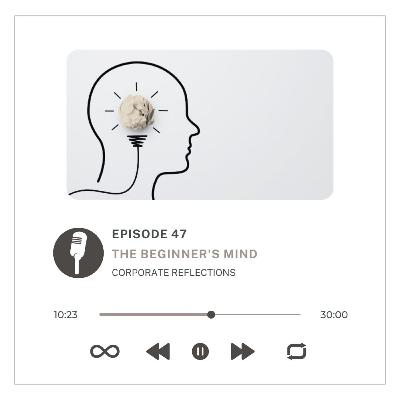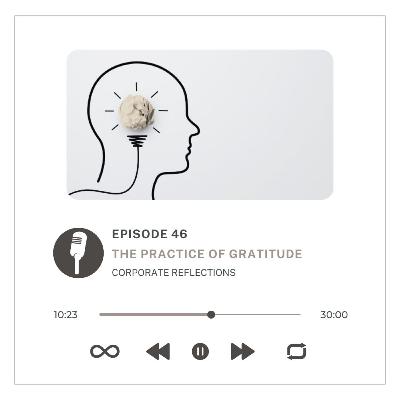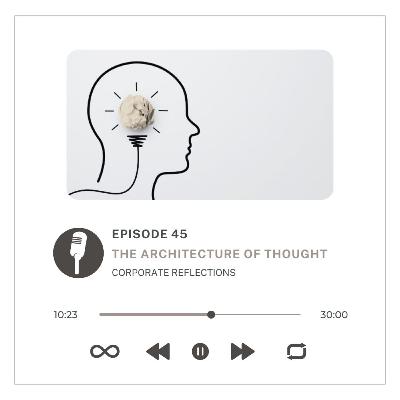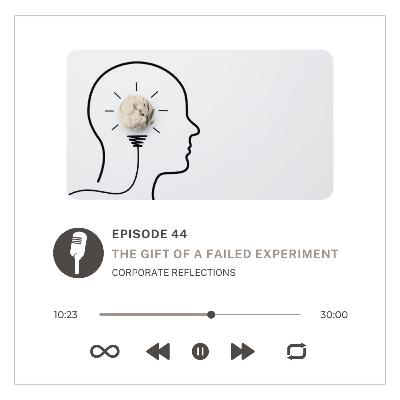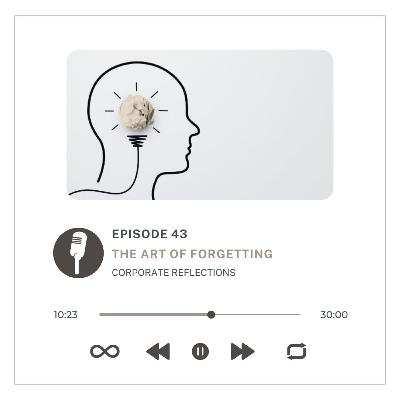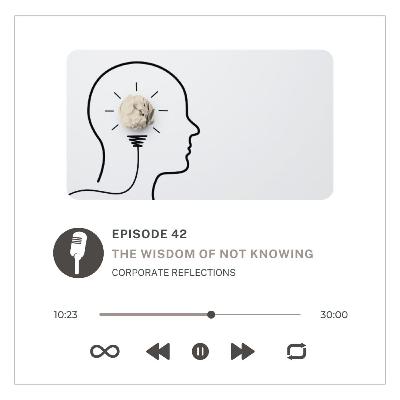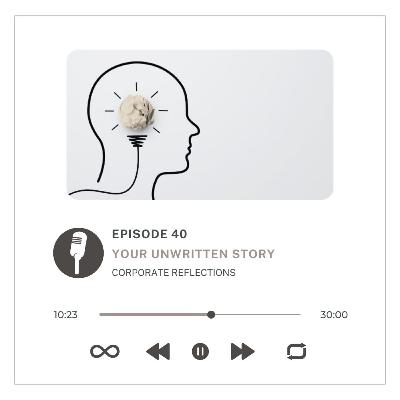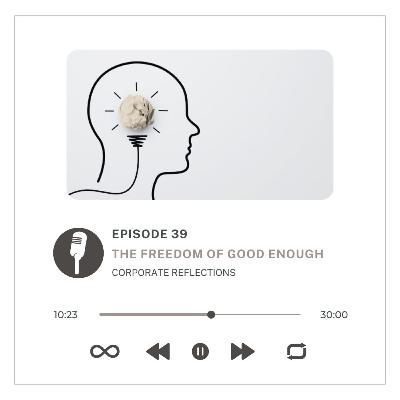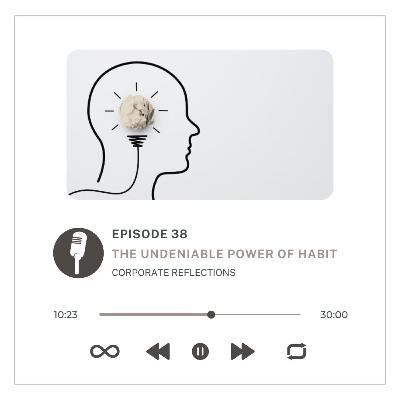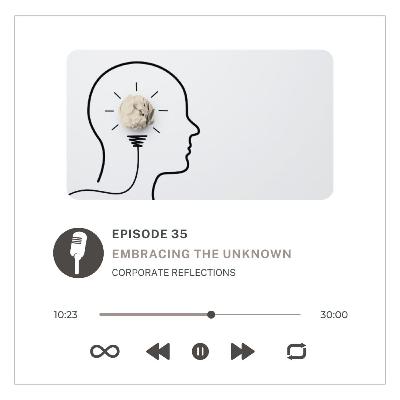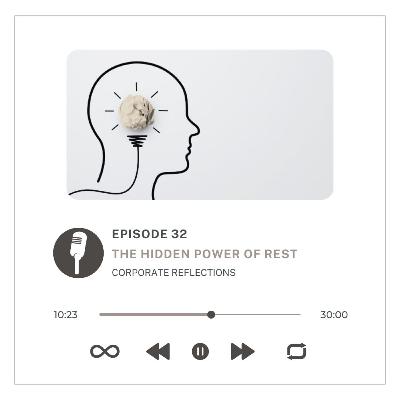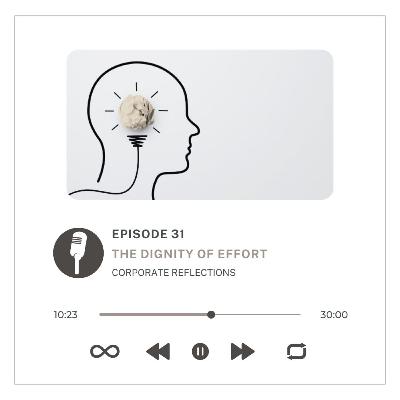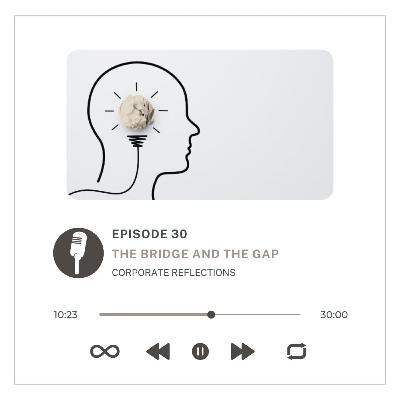Discover Corporate Learning with Jardine
Corporate Learning with Jardine

Corporate Learning with Jardine
Author: Jardine Ong
Subscribed: 2Played: 7Subscribe
Share
© Jardine Ong
Description
Corporate Learning Excerpts for Learning Organizations offer bite-sized learnings from some of my Corporate Training Workshops on Communication, Etiquette, Customer Service, Sales, Management and Leadership.
Speaker's Profile : https://www.proficiopx.com/proficiopx-director-jardine-ong
Speaker's Profile : https://www.proficiopx.com/proficiopx-director-jardine-ong
49 Episodes
Reverse
This reflection draws on a number of concepts and ideas, which can be linked to several prominent thinkers and philosophies. The core themes revolve around embracing imperfection, authenticity, and the value of flaws, and they are inspired by the following : • Wabi-Sabi : This is a Japanese aesthetic and worldview that finds beauty in imperfection, transience, and incompleteness. It's often associated with rustic simplicity and a deep appreciation for the natural aging of things. The text's examples of a worn-out book, an antique chair, and a handmade quilt directly reflect this concept. Wabi-Sabi teaches that true beauty is found in the cracks and marks of time, which tell a story rather than representing a flaw.• Brene Brown's work on vulnerability and shame : The author's work, particularly her research on shame, vulnerability, and courage, is a clear inspiration. She argues that vulnerability—being imperfect and showing up as your authentic self—is not a weakness but the birthplace of connection, innovation, and change. The idea that "when we are brave enough to be imperfect, we give others permission to be imperfect too" is a central tenet of her work.• Humanistic Psychology. : This school of thought, with figures like Carl Rogers and Abraham Maslow, emphasizes the inherent worth of the individual and the importance of self-acceptance and authenticity. Rogers, in particular, stressed the concept of "unconditional positive regard," which involves accepting a person without judgment, regardless of their faults. This is echoed in the reflection's call to let go of self-criticism and embrace one's whole, imperfect self.• Kintsugi : This is another Japanese art form that involves repairing broken pottery by mending the areas of breakage with lacquer dusted or mixed with powdered gold, silver, or platinum. The philosophy behind it is that the piece is more beautiful for having been broken and repaired, as the cracks and repairs become part of its history rather than something to be hidden. The reflection's statement that "our scars aren't signs of weakness; they are proof of our resilience" and its focus on the beauty of imperfections are a direct parallel to the philosophy of Kintsugi.In short, the reflection is a modern blend of these ancient and contemporary ideas, all pointing to the same conclusion: that the messy, imperfect parts of life are what make it beautiful and meaningful.
The concepts presented are a blend of established ideas from psychology, communication theory, and personal development. Here are the concepts and thinkers that informed the reflection :• Proactive vs. Reactive Behavior : The core idea of moving from a reactive "wall" to a proactive "fence with a gate" is a central theme in many self-help and psychological frameworks. This concept is most famously associated with Stephen Covey's book, The 7 Habits of Highly Effective People. In it, he defines the first habit as being proactive, which means taking responsibility for one's own life and actions instead of reacting to external circumstances.• Reciprocity in Relationships : The reflection highlights that boundaries are a "two-way street" based on mutual respect. This idea is a fundamental principle in relationship psychology and is explored in detail by various family therapists and social psychologists. The concept of reciprocity in social interactions has been studied extensively by thinkers like Robert Cialdini, who wrote Influence: The Psychology of Persuasion. While his work often focuses on persuasion, the underlying principle of give-and-take is a cornerstone of healthy relationships.• Assertive Communication : The emphasis on "clear and kind" communication to prevent stress and confusion is a key component of assertive communication. Unlike aggressive or passive communication, being assertive involves expressing your needs and feelings directly and respectfully. This concept was popularized by various therapists and authors in the mid-20th century. Pioneers like Manuel J. Smith, author of When I Say No, I Feel Guilty, helped define and popularize the techniques for setting boundaries without feeling guilt or aggression.• Inspiration from Therapy and Personal Development : The idea of boundaries as a creative act rather than a defensive one is a recurring theme in modern therapy and personal development literature. Many contemporary therapists and life coaches, such as Nedra Glover Tawwab, author of Set Boundaries, Find Peace, often reframe the concept of boundaries to be about self-respect and intentional living. Her work, like the reflection, shifts the focus from feeling guilty or selfish for setting boundaries to seeing them as an essential part of a healthy, fulfilling life.The reflection synthesizes these powerful concepts into a cohesive message. It borrows from the practical wisdom of communication and leadership experts, the principles of relationship psychology, and the modern, compassionate approach of personal development coaches. The overall tone aligns with a movement that encourages people to take a more active and empowered role in shaping their lives and relationships.
This reflection is directly inspired by the Zen Buddhist concept of Shoshin, or "Beginner's Mind." This philosophy is a central theme in the work of Shunryu Suzuki, a Zen monk who helped popularize these ideas in the West.The core inspirations are : • Shunryu Suzuki's book, Zen Mind, Beginner's Mind: The title and the primary concept of the reflection are taken directly from this influential work. Suzuki taught that the true practice of Zen is to maintain an open, empty mind, free from habits and expectations.• The contrast between expertise and curiosity: The reflection highlights the double-edged sword of experience. While expertise brings efficiency, it can also lead to arrogance and a closed mind. The reflection argues for a balance between the two.• A critique of intellectual arrogance: It challenges the modern tendency to believe that knowledge and experience provide all the answers, suggesting that true wisdom lies in the ability to admit what you don't know and to remain open to new learning.The reflection takes an ancient philosophical concept and applies it to modern life—work, relationships, and personal growth—making it a relevant and practical tool for self-improvement.
This reflection on gratitude draws inspiration from a variety of concepts and thinkers : • Positive Psychology: The entire reflection is a perfect example of Positive Psychology, a school of thought founded by Martin Seligman and Mihaly Csikszentmihalyi. This field moves beyond traditional psychology's focus on mental illness and instead studies human flourishing, happiness, and well-being. Gratitude is a cornerstone practice in this area, and the reflection's emphasis on "rewiring your brain" and the proven benefits (lowered stress, improved sleep) directly reflects the scientific findings of positive psychology researchers like Robert A. Emmons and Michael E. McCullough, who have conducted extensive studies on the topic.• Stoicism: The opening lines, with their emphasis on focusing on "what is already here" rather than "what we lack," strongly echo Stoic philosophy. Thinkers like Marcus Aurelius, Seneca, and Epictetus taught that true happiness comes from within and that we should focus our attention on what we can control—our thoughts and our actions—rather than external circumstances. The practice of focusing on what one has, rather than what one desires, is a fundamental Stoic exercise.• Mindfulness and Meditation: The call to "take a moment to simply stop," "pause, look around, and acknowledge what is already here," is a direct nod to mindfulness. Jon Kabat-Zinn, who popularized mindfulness-based stress reduction (MBSR), defines mindfulness as "paying attention in a particular way: on purpose, in the present moment, and non-judgmentally." The reflection encourages this exact practice, using gratitude as the focal point.• Personal Development and Self-Help Literature: The tone and structure of the reflection—starting with a problem (the rush of life), presenting a solution (gratitude), offering practical steps, and ending with an encouraging challenge—is characteristic of modern self-help and personal development genres. Figures like Oprah Winfrey, who has long championed the practice of keeping a gratitude journal, and authors like Brené Brown, who writes about vulnerability and the power of everyday moments, have made these concepts widely accessible and relatable to a mainstream audience.
This reflection is a blend of ideas from psychology, philosophy, and personal development.• Cognitive Behavioral Therapy (CBT) : The core concept that our thoughts determine our feelings and actions comes from Cognitive Behavioral Therapy, developed by figures like Aaron T. Beck. The reflection's advice to replace a limiting story with a new one ("I'm not creative enough" with "Today is a new day to learn") is a foundational technique of CBT, which focuses on identifying and reframing negative thought patterns.• Stoicism : The idea of controlling our thoughts rather than being controlled by external events is a central tenet of Stoicism, an ancient philosophy practiced by figures like Marcus Aurelius and Epictetus. The reflection's emphasis on building with strong "internal architecture" rather than relying on external circumstances is a direct application of Stoic philosophy.• Habit Formation : The use of an architectural metaphor—the building being made of small, individual bricks—is a powerful illustration of modern habit formation theories. The concept that monumental change comes from small, consistent efforts is the main message of James Clear in his book, Atomic Habits, and B.J. Fogg with his Tiny Habits method. The reflection’s focus on the "micro-level" actions of thought and habit is directly inspired by their work.
This reflection is inspired by concepts from several fields, primarily psychology, business, and the philosophy of science : • Karl Popper : His work on falsifiability argued that a scientific theory is only valid if it can be proven wrong. He championed the idea that the goal of a scientist isn't to prove a theory is right, but to test it rigorously and be ready to discard it if it fails. The reflection’s advice to see a mistake as a "data point" and a "failed experiment" mirrors this core tenet of modern scientific thought. • Growth Mindset : The reflection's message that failure is not a permanent state but an opportunity for learning is a central idea in modern psychology.• Carol Dweck: Her work on "growth mindset" is the primary inspiration. She contrasts a "fixed mindset" (where people believe their abilities are static and see failure as a personal flaw) with a "growth mindset" (where they believe abilities can be developed and see failure as a chance to learn and grow). The reflection’s reframing of failure as a gift of new data is a perfect example of a growth mindset in action.• Lean Startup Methodology : In the world of business and entrepreneurship, the concept of "failed experiments" is a foundational principle.• Eric Ries: His book, The Lean Startup, popularized the idea of "validated learning." Instead of building a product in secret for years and hoping it succeeds, he advocates for a build-measure-learn feedback loop. A product that doesn't sell isn't a failure in this model; it's an experiment that provided valuable data about what customers actually want.
The reflection "On the Art of Forgetting" draws from several widely-held ideas :• The Psychology of Forgiveness and Letting Go : The reflection's core idea is a metaphor for forgiveness, not just of others, but of oneself. Psychologists often emphasize that holding onto grudges, guilt, and past failures is detrimental to mental health. The act of "forgetting" in this context is a synonym for releasing these emotional burdens.• Buddhist Philosophy : Concepts in Buddhism, such as non-attachment and the idea that suffering comes from holding on to the past or future, are a clear influence. The reflection's call to "disarm" the past and "release the burdens" echoes these teachings.• Cognitive Behavioral Therapy (CBT) : The reflection aligns with CBT principles that encourage individuals to challenge and reframe negative self-talk and limiting beliefs. "Forgetting the narrative" that one isn't good enough is a direct application of this therapeutic approach.In essence, the inspiration is the collective wisdom found across various disciplines that the path to a more peaceful and fulfilling life often lies not in remembering everything, but in consciously and courageously choosing what to let go of.
This reflection draws inspiration from several thinkers who challenged conventional notions of knowledge and certainty : • The Socratic Paradox ("I know that I know nothing") by Socrates : This is the most direct and foundational inspiration. Socrates’s entire philosophical method was built on the premise that true wisdom begins with the admission of one's own ignorance. By asking questions and revealing the lack of knowledge in those who claimed to be experts, he demonstrated that the person who knows they don't have all the answers is a step ahead of those who believe they do. The reflection's core argument—that "I don't know" is a doorway to wisdom—is a direct echo of Socratic thought.• The Growth Mindset by Carol Dweck : This modern psychological concept perfectly explains the second half of the reflection. Dweck's work distinguishes between a "fixed mindset" (believing intelligence and ability are static traits) and a "growth mindset" (believing they can be developed through effort and learning). The reflection’s contrast between "a fixed, rigid structure" of knowledge and an "evolving map," and its focus on "discovery" and "growth," are core tenets of Dweck's theory.• The Power of Vulnerability by Brené Brown : While not explicitly mentioned, the application of this idea to leadership and relationships strongly aligns with Brown’s research. She argues that showing vulnerability—such as admitting a mistake or saying "I don't know"—is a sign of courage and is essential for building trust and genuine connection in both professional and personal settings.• Falsifiability by Karl Popper: In the philosophy of science, Popper argued that a scientific theory is only valuable if it can, in principle, be proven wrong (falsified). This concept reinforces the idea that all knowledge is provisional and open to revision. The reflection's premise that a mind must be open to changing its view is a philosophical extension of Popper's scientific principle
This reflection is inspired by ideas from self-help, psychology, and personal development : • The "Just Do It" Mentality : This core idea is about overcoming procrastination and inaction. The passage challenges the notion of waiting for the "perfect moment," a common form of self-sabotage.• Mel Robbins: Her book and TED Talk, The 5 Second Rule, are built on this exact principle. She argues that when you have an impulse to act on a goal, you must physically move within five seconds, or your brain will kill the idea. Her work focuses on the power of taking immediate action to overcome hesitation and fear.• The Power of Small Steps : The reflection emphasizes that progress comes not from a single giant leap, but from a series of small, manageable actions. This concept is central to behavioral change and habit formation.• James Clear : In his best-selling book Atomic Habits, Clear details how small, incremental improvements—which he calls "atomic habits"—compound over time to create remarkable results. He focuses on the system of building habits rather than the end goal itself.• B.J. Fogg : A behavioral scientist at Stanford, Fogg developed the Tiny Habits method. His work focuses on making new habits so small that it's nearly impossible to fail, such as flossing just one tooth after brushing or doing two push-ups after using the bathroom. • Steven Pressfield : In his influential book The War of Art, Pressfield personifies this internal force as "Resistance." He describes it as a universal, negative force that prevents us from doing our creative work or pursuing our truest calling.
The reflection "Your Unwritten Story" is inspired by the universal themes of personal growth, destiny, and the power of choice. It is based on several widely shared psychological and philosophical ideas : • The Power of Narrative : The reflection uses the metaphor of a story to frame a person's life. This is a common and powerful tool in self-help and psychology, where individuals are encouraged to see themselves as the protagonist of their own life story. The idea that we can edit or rewrite our narratives is a key component of cognitive and narrative therapy. • Existentialism and Free Will: The concept that "you are the author" and that your future is "not a fixed script" aligns with existentialist thought, which emphasizes individual freedom, responsibility, and the idea that our choices define our essence.• Mindset and Growth: The reflection encourages a growth mindset, which is the belief that abilities and intelligence can be developed through dedication and hard work. It directly counters a fixed mindset, which would suggest that a person's future is predetermined by their past.• The "Clean Slate" Mentality: It speaks to the feeling many people have of being defined by their past mistakes or failures. The reflection offers a hopeful perspective by highlighting that the future is not bound by the past, and that every new day is an opportunity to write a new, better chapter.In essence, the inspiration for this reflection is the hopeful and empowering idea that no matter what has happened, a person's future remains unwritten and is theirs to create.
This reflection is a combination of several well-established psychological concepts and common human experiences : • The Pursuit of Perfection: The reflection directly addresses the modern societal pressure to achieve perfection, a phenomenon often tied to social media and a competitive culture. It recognizes that this pursuit is often a source of anxiety and burnout. • Psychology of "Good Enough": The core concept of "good enough" is a central idea in the work of psychoanalyst Donald Winnicott, who introduced the idea of the "good enough mother." In a broader context, this concept has been applied to personal development, productivity, and self-compassion. The reflection argues that aiming for perfection is often paralyzing, while striving for "good enough" is an act of liberation that allows for action and progress.• Self-Compassion: The idea that "good enough" is an act of self-compassion is a key theme. It’s about being kind to yourself and accepting your own imperfections, rather than a sign of laziness or a lack of ambition. This aligns with the work of researchers like Kristin Neff, who have highlighted the importance of self-compassion for mental well-being.• The Paradox of Action: The reflection highlights a common human paradox: the fear of imperfection often prevents us from even starting. By reframing "good enough" as a valid and powerful goal, it gives permission to take action and begin the journey, even if the first steps aren't flawless.
The reflection is inspired by the modern self-help and behavioral science movements, particularly the work of several key authors and thinkers. The core concepts are :• "Atomic Habits" of James Clear, the idea of tiny, fundamental actions that, when compounded over time, lead to remarkable results. He's known for the "1% rule," (monumental achievements are not the result of sudden, Herculean efforts but rather the compounding effect of tiny, daily improvements),habit stacking (new habits can be built by attaching them to existing ones), and the emphasis on building a system of habits (The idea that "big results are simply the accumulation of small, consistent actions performed over time")• "Tiny Habits" of B.J. Fogg, champions the idea of starting with small, easy-to-do habits. His "Tiny Habits" model focuses on making new behaviors so simple that it's impossible to fail at them, thereby building momentum and making the habit stick.• "Habit loop" (Cue, Routine, Reward), from Charles Duhigg's The Power of Habit, delves into the explains how habits are formed and how they can be changed. While the reflection focuses more on the accumulation of habits, Duhigg's work provides the fundamental understanding of the mechanics behind how habits are built.
The reflection was inspired by the evolution of thinking surrounding the relationship between work and personal life. It synthesizes key concepts from several fields, particularly modern psychological theories and business leadership principles.• Work-Life Integration vs. Balance : The central idea of moving from a rigid "balance" (a 50/50 split) to a more fluid "harmony" or "integration" is a concept discussed by many thought leaders. This shift acknowledges that separating work and life into distinct boxes is often unrealistic, especially with the rise of technology and remote work. The goal becomes creating a dynamic flow where different aspects of life can coexist and support each other, rather than competing for equal time.• Mindfulness and Presence : The emphasis on being "present wherever you are" draws heavily from the principles of mindfulness. This concept, popularized by figures like Chade-Meng Tan from Google's "Search Inside Yourself" program, teaches that true well-being comes from non-judgmental, moment-to-moment awareness. Applying this to a work-life context means fully engaging in the task at hand, whether it's a work meeting or a family dinner, and letting go of the guilt of not being somewhere else.• Self-Determination Theory : The reflection's focus on defining "what's important to you" and setting "non-negotiables" aligns with aspects of self-determination theory. This psychological framework, developed by Edward L. Deci and Richard M. Ryan, posits that people are motivated by fundamental psychological needs, including autonomy (the need to control one's life) and relatedness (the need to connect with others). By consciously defining priorities, individuals regain a sense of autonomy and ensure their activities align with their personal values, leading to greater well-being and reduced burnout.
The reflection comes from a combination of common human experiences and a philosophical perspective on personal growth : • The universal human fear of uncertainty : People naturally seek predictability and control to feel safe. The reflection draws on this innate fear as a starting point, making it immediately relatable.• The idea of a "growth mindset" : This is the belief that abilities can be developed through dedication and hard work. The speech's message that "that feeling of growth, of moving from novice to competent, is exhilarating" is a direct application of this idea.• The concept of "taking a leap of faith" : This is a common metaphor for taking a risk on something without a guarantee of success. The phrase "leap of faith" has been used for centuries to describe an act of trusting in something unknown, and it's a powerful and relatable image.• The idea of a "narrative arc" or a "story" : It suggests that a life with unexpected twists and turns is not a failure, but a more compelling and meaningful story. This idea is a common theme in literature, film, and biographical accounts of successful people.
The Power of Yet" is inspired by thework of Dr. Carol Dweck, a Stanford University psychologist. She is a leading researcher in the field of motivation and has extensively studied what she calls the "growth mindset."Dweck's research distinguishes between two mindsets :• Fixed mindset : The belief that our abilities and intelligence are fixed traits and cannot be changed. People with this mindset may avoid challenges and give up easily to protect their self-image.• Growth mindset : The belief that our abilities and intelligence can be developed through dedication and effort. People with this mindset embrace challenges, learn from their mistakes, and see setbacks as opportunities to grow.The concept of "yet" is a cornerstone of Dweck's work on the growth mindset. It's a simple but powerful word that transforms a statement of limitation ("I can't do this") into one of potential and progress ("I can't do this yet"). She has shared this idea in various talks, including a popular TED Talk, and in her book, Mindset: The New Psychology of Success.The reflection is a simplified and accessible version of her core message, designed for practice. It aims to encourage people to adopt a growth mindset by highlighting the transformative power of a single word.
The reflection on "The Unexpected Gift of Boredom" is inspired by a number of modern cultural observations and psychological theories.The central idea is a reaction to our current reality: the constant availability of digital stimulation, which has made moments of quiet and reflection increasingly rare. The feeling of "boredom" is now often seen as an annoyance to be instantly eliminated, rather than a natural state of mind.The underlying psychological and creative concepts that inspired the speech include :• Creativity and the Default Mode Network (DMN): Neuroscientists have studied the "default mode network," a set of brain regions that become active when we are not focused on an external task. This network is associated with daydreaming, future planning, and self-reflection. When we are bored, we are often in this state, and many creative breakthroughs and "Aha!" moments occur during these periods of unfocused thought.• Mindfulness and Presence: The reflection is also a gentle nudge towards the practice of mindfulness, which encourages being present in the moment. By resisting the urge to reach for a distraction, one can become more aware of their thoughts and surroundings, leading to a richer experience of life.• The "Slow" Movement: The reflection taps into a broader cultural shift that values slowing down, disconnecting from technology, and embracing a more deliberate pace of life. This movement is a response to the "always-on" nature of modern society.The reflection synthesizes these ideas into a single, compelling argument : that what we often see as a negative—boredom—is actually a valuable state of mind that we should embrace rather than avoid.
This reflection is a blend of several influential ideas and cultural observations.• Critique of "Hustle Culture" : The reflection directly addresses and challenges the modern cultural obsession with constant productivity and busyness, often called "hustle culture." This is a widespread social phenomenon in which people feel pressure to work constantly and view rest as unproductive or lazy. The reflection argues against this mindset, which is a common theme in recent mental health and self-care discourse.• Nature as a Teacher : The reflection uses analogies from nature—musicians, athletes, and seasons—to illustrate its point. This approach, where natural cycles and phenomena are used to explain human behavior and well-being, is a common rhetorical device found in philosophy and spiritual teachings. It suggests that our own need for rest is not a personal failure but a fundamental, universal principle.• The Paradox of Rest : The central idea of the reflection is a paradox: that rest is not the opposite of productivity but an essential component of it. This concept is supported by research in psychology and neuroscience, which shows that taking breaks and getting adequate sleep improves cognitive function, creativity, and overall performance. The reflection reframes rest from a passive act to an active and necessary one for long-term success.• The Importance of Unstructured Time : The reflecfion implicitly advocates for unstructured time and downtime. This is a concept explored in various works on creativity and innovation, which argue that our best ideas often come not from intense focus but from moments of relaxation and daydreaming.
This reflection is inspired by several philosophical and psychological concepts, as well as a critique of modern culture :• Process vs. Outcome : A core inspiration is the idea that the process of work and growth is often more valuable than the final outcome. This is a common theme in mindfulness, Stoicism, and many Eastern philosophies that emphasize the journey over the destination.• A Critique of "Results-Only" Culture : The reflection pushes back against a culture that is often obsessed with metrics, grades, and visible success. It argues that this focus can devalue the unseen work, character building, and resilience that are forged through consistent effort.• Growth Mindset : The psychologist Carol Dweck's work on "growth mindset" is a major influence. A growth mindset values effort, learning, and resilience over innate talent. It posits that a person's abilities can be developed through dedication and hard work. This directly aligns with the message that "the dignity of effort" is what builds character.• Stoicism : The Stoic philosophers, such as Marcus Aurelius, emphasized focusing on your own actions and virtues (your effort) rather than on external results, which are often out of your control. This is the essence of the speech's message.• The "Worthy Struggle" : The reflection touches on the idea that a struggle, even if it doesn't lead to a desired outcome, is still valuable. This concept is celebrated in literature, sports, and business, where resilience and perseverance are seen as noble virtues.The reflection’s inspiration is a blend of ancient wisdom and modern psychology, aimed at providing a counter-narrative to a culture that often overlooks the value of the journey.
The reflection "The Bridge and the Gap" is an original piece inspired by the prevalent themes of polarization, division, and the search for common ground in contemporary society. The key inspirations for the reflection include: • Political and Social Polarization: The reflection directly addresses the increasing ideological and social divides seen in many countries. The "gap" is a metaphor for these divides, whether they are political, cultural, or generational. • The Concept of Empathy and Dialogue: It's inspired by the work of psychologists, sociologists, and community leaders who emphasize the importance of active listening and finding shared values as a way to overcome conflict. • Historical and Modern Leaders: While not naming anyone, the "bridge builder" archetype is inspired by leaders throughout history who have sought to unite people across divides. This could be anyone from civil rights leaders to diplomats to grassroots organizers who work to bring opposing groups together. • The metaphor of the bridge: The bridge is a classic and powerful symbol of connection, progress, and overcoming obstacles. Using this metaphor helps to make an abstract concept (like reducing polarization) feel concrete and actionable.In short, this is a reflection on the need for unity and understanding in a fragmented world, and a call to action to move beyond division by focusing on what connects us rather than what separates us.
The reflection on "The Practice of Releasing Control" is inspired by a wide range of philosophical and psychological concepts.The central idea is a common theme in both Eastern and Western thought, particularly in :• Stoicism : The Stoic philosophers, like Epictetus and Marcus Aurelius, placed a high value on distinguishing between what is within our control and what is not. They argued that our tranquility and freedom come from focusing our efforts and emotional energy only on what we can influence (our thoughts, actions, and judgments) and accepting what we cannot control (external events, other people's actions, and outcomes).• Mindfulness and Acceptance: The reflection aligns with core principles of mindfulness. It encourages a shift from a "doing" mode (constantly trying to fix or change things) to a "being" mode (accepting the present moment as it is). This acceptance is not passive resignation but a conscious choice to stop fighting reality.• Anxiety and Stress Research: Modern psychology and mental health practices frequently address the link between the need for control and high levels of anxiety. The reflection offers a therapeutic perspective, suggesting that letting go of control is a practical and effective way to reduce stress and find peace.The reflection synthesizes these ideas into a practical message: that the illusion of total control is a burden, and true strength lies in the wisdom to let go of what is beyond our grasp.


